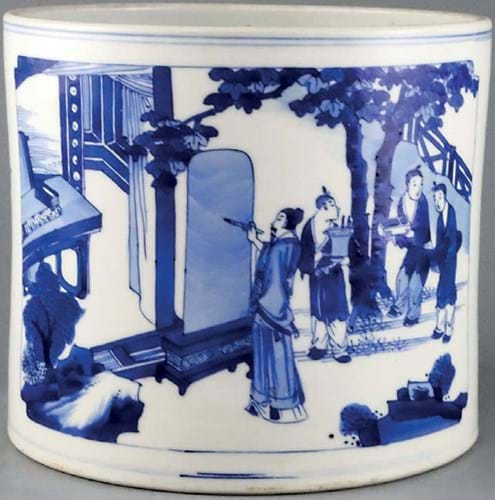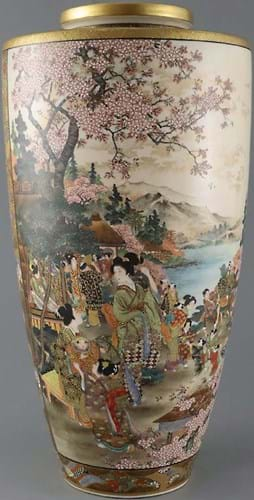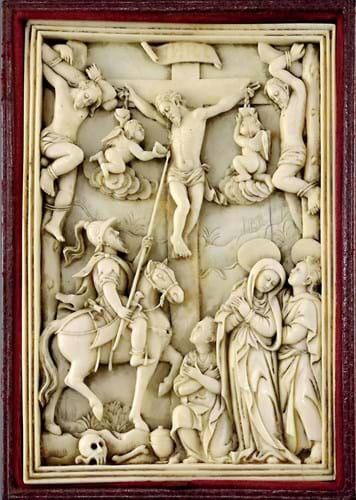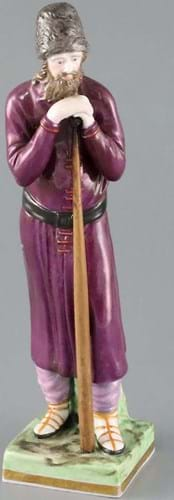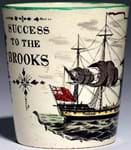Top-seller among nearly 90 Chinese lots was a Kangxi blue and white brush pot or bitong.
Dated c.1700-15, the 7in (18cm) tall vessel was painted with a scholar and assistants to one side and a seven-column inscribed poem to the reverse. It featured a studio seal mark mu shi (bamboo and rock) – one seen on several porcelains of the period likely to have been the name of a private kiln.
The pot had a small chip to the foot but, against a £10,000-15,000 estimate at the sale on March 10, it sold at £35,000. Keen Chinese interest was evident but the London trade, always strong bidders for Kangxi wares, bought it.
Daoguang marks
A Chinese buyer bought two pieces with Daoguang (1821-50) marks which also went well above high hopes.
A pair of 4½in (11.5cm) diameter yellow ground famille rose ‘medallion’ bowls with six-character seal marks were catalogued as ‘probably of the period’. Painted to the exterior with lotus flowers and foliage, they were estimated at £12,000-16,000 and made £22,000.
Catalogued as of the period, a ‘duck and lotus’ bowl using the twice-fired doucai technique topped that. It was painted to the exterior with an underglaze blue band of dragons chasing the flaming pearl and overglaze with mandarin ducks swimming among lotus blossoms. To the interior was a central medallion of a pair of ducks in a lotus pond.
In May 2017 a pair of similar bowls took £72,000 at Sotheby’s in London. The single bowl at Gorringe’s, estimated at £8000- 12,000, made £25,000.
Meiji ceramics
Items bearing the seal marks of three of the greatest names in Meiji ceramics led the Japanese section.
A 15in (37.5cm) tall, exhibition quality Satsuma vase finely painted with figures and boats in a mountainous landscape bore a gilt nine-character seal. It was marked for Kyoto Ryozan along with the trademark of the Yasuda Company and the mon of the Shimazu family. Estimated at £4000-6000, this vase went to a UK collector at £10,000.
Other Meiji prizes included a pair of pottery vases by Yabu Meizan and a moulded bowl from the Kinkozan Kyoto studios, both of which were bought by a London specialist dealer.
Yabu Meizan (1853-1934) opened his Osaka workshop in 1880, but quickly became highly regarded in Japan and then a hugely successful exporter to the West.
His 4¾in (12cm) tall ovoid vases offered in Lewes were painted to the upper half with figures of artisans and scholars and, below, with figures in boats. Bearing gilt four-character seal marks, the vases, pitched at £3000- 5000, went at £5500.
In contrast with Meizan, the Kinkozan family had been producing wares from their Kyoto studios since 1645 and began exporting to the West during the 1850s. During the Meiji period they became Japan’s largest producers of Satsuma ware until the factory closed in 1927.
The 8¼in (21cm) diameter moulded bowl at Gorringe’s, featuring bamboo-shaped basketwork ribs and painted with panels of millefleur to the exterior and white flowers to the interior, was impressed with the four-character mark to the base. Against expectations of £1500- 2000, the bowl sold at £4400.
Religious pieces
Two Euro-Asiatic religious ivory pieces went well above expectations.
A 6in (15cm) relief depicting the Crucifixion catalogued as Hispano- Filipino or Sino-Portuguese was probably late-16th or early-17th century and relates to an near-contemporary engraving by Flemish artist Jan Sadeler.
In a later fitted case, the ivory was pitched at £3000-5000 but sold online to a London specialist at £10,000 against Portuguese and Spanish competition.
Also of Portuguese interest was a 9½in (24cm) Indo-Portuguese ivory group of Christ as the Good Shepherd. Dated to the 17th or 18th century, it more than doubled top hopes at £3400 via an internet bidder.
Gardner figures
Appealing to a very different collecting audience, but an equally vibrant niche market, are the ‘regional types’ figures produced at the porcelain factory set up outside Moscow by English entrepreneur Francis Gardner in 1776.
The 8½in (21.5cm) tall example at Gorringe’s dated from the mid-19th century. It had suffered loss to the left hand and his staff was a replacement but the £200-300 estimate always had a here-to-sell look about it.
After arousing wide Russian and East European interest, the figure went back to Moscow via thesaleroom.com at £6500.
Best of British
British-made successes featured throughout the sale.
A 12in (30cm) diameter late-18th or early-19th century English baking dish with a slipware lattice design on a brown background cream went to the London trade at a quadruple-estimate £2800.
Dating to c.1885 was a Doulton Lambeth flambé bottle vase standing 8in (19cm) tall. Decorated with an entwined mythical beast and incised MVM for the designer Mark V Marshall, it sold to a collector at £1800 (estimate £200-300).
Best of the furniture was a 3ft 6in (1.07m) diameter Regency giltwood and gesso convex wall mirror. With a carved, ribbon-tied laurel wreath frame and a later plate, it went above estimate to the northern English trade at £5500.
Topping the silver was a pair of embossed, inverted pear tea caddies and matching sugar box by Samuel Taylor, London, 1752, which went within estimate to a local collector at £3200.


